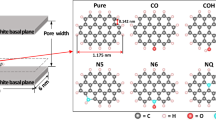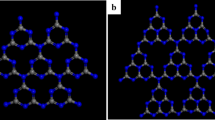Abstract
Biogas is one of the most common sources of biomass energy. Due to the associated environmental pollution and costs, desulfurization, and purification are the most important challenges of biogas power generation. Using all-atom molecular dynamics (MD), we systematically simulated the isothermal adsorption behavior of biogas (comprising CH4, CO2, H2O, H2S, and H2) in graphite (Gr) slit nanopores. The impact of slit width, system temperature, and moisture content on the adsorption energy, adsorption ratio, and diffusion coefficient of biogas molecules was investigated. Simulation results revealed that due to strong interactions between graphite and H2S, graphite slits of width d = 48 ~ 80 Å displayed significant selective adsorption of H2S molecules. At temperatures between 300 and 500 K, Gr slits can effectively separate H2S in biogas. Moreover, as the moisture content of biogas (vol%) increases from 0 to 20%, the formation and interactions of hydrogen bonds between water molecules create H2O films accumulating on the Gr surface and taking up the adsorption sites, which reduces the amount of hydrogen sulfide that can be adsorbed. Our findings provide important insights into the material design for biogas purification.
Graphical Abstract
A schematic representation of molecular interactions between adsorbates and the wall for biogas mixtures (comprising CH4, CO2, H2O, H2S, and H2) inside graphitic nanopores.








Similar content being viewed by others
Data availability
All the data generated or analyzed during this work are included in this published article.
Code availability
N/A.
References
Ryckebosch E, Drouillon M, Vervaeren H (2011) Techniques for transformation of biogas to biomethane. Biomass Bioenerg 35(5):1633–1645
Ganiyu SA, Lateef SA (2021) Review of adsorptive desulfurization process: overview of the non-carbonaceous materials, mechanism and synthesis strategies. Fuel 294:120273
Xu J, Wu C, Yan P, Zhang R, Yue X, Ge S (2014) Pore characteristics of carbide-derived carbons obtained from carbides with different carbon volume fractions. Microporous Mesoporous Mater 198:74–81
Laudisio G, Dash RK, Singer JP et al (2006) Carbide-derived carbons: a comparative study of porosity based on small-angle scattering and adsorption isotherms. Langmuir 22(21):8945–8950
Prasetyo I, Mukti NIF, Cahyono RB et al (2020) Nanoporous carbon prepared from palm kernel shell for CO2/CH4 separation. Waste Biomass Valori 11(10):5599–5606
Heck HH, Hall ML, dos Santos R et al (2018) Pressure swing adsorption separation of H2S/CO2/CH4 gas mixtures with molecular sieves 4A, 5A, and 13X. Sep Sci Technol 53(10):1490–1497
Kuo JK, Tsai YT, Huang PH et al (2021) Capture of acidic gas molecules in metallic nanopillar array surfaces. J Mol Model 27:139
Cheng G, Long DH, Liu XJ et al (2009) Fabrication of hierarchical porous carbide-derived carbons by chlorination of mesoporous titanium carbides. New Carbon Mater 24(3):243–250
Xing W, Liu C, Zhou Z, Zhou J et al (2014) Oxygen-containing functional group-facilitated CO2 capture by carbide-derived carbons. Nanoscale Res Lett 9(1):1–8
Huang PH, Cheng HH, Lin SH (2015) Adsorption of carbon dioxide onto activated carbon prepared from coconut shells. J Chem 2015:1–10
Wickramaratne NP, Jaroniec M (2013) Importance of small micropores in CO2 capture by phenolic resin-based activated carbon spheres. J Mater Chem A 1(1):112–116
Chen C, Kim J, Ahn WS (2012) Efficient carbon dioxide capture over a nitrogen-rich carbon having a hierarchical micro-mesopore structure. Fuel 95:360–364
Shi F, Pei Z, Wang S et al (2016) Dynamic experiment of biogas desulfurization by activated carbon. Trans Chi Soc Agric Eng 32(9):187–192
Xiong J, Luo J, Di J et al (2020) Macroscopic 3D boron nitride monolith for efficient adsorptive desulfurization. Fuel 261:116448
Heuchel M, Davies GM, Buss E et al (1999) Adsorption of carbon dioxide and methane and their mixtures on an activated carbon: simulation and experiment. Langmuir 15(25):8695–8705
Jia X, Zhang H, Zhang Z et al (2019) First-principles investigation of vacancy-defected graphene and Mn-doped graphene towards adsorption of H2S. Superlattices Microstruct 134:106235
Gonçalves DV, Paiva MA, Oliveira JC et al (2018) Prediction of the monocomponent adsorption of H2S and mixtures with CO2 and CH4 on activated carbons. Colloids Surf, A 559:342–350
Xu J, Sang P, Xing W et al (2015) Insights into the H2/CH4 separation through two-dimensional graphene channels: influence of edge functionalization. Nanoscale Res Lett 10(1):1–10
Cracknell RF, Nicholson D (1994) Grand canonical Monte Carlo study of Lennard-Jones mixtures in slit pores. Part 3.—Mixtures of two molecular fluids: ethane and propane. J Chem Soc 90(11):1487–1493
Akbarzadeh H, Abbaspour M, Salemi S et al (2017) Injection of mixture of shale gases in a nanoscale pore of graphite and their displacement by CO2/N2 gases using molecular dynamics study. J Mol Liq 248:439–446
Huang PH, Cheng CC, Liao YK, Lin CH, The research report, Ministry of Science and Technology, R.O.C. The grant No. MOST 109–2221-E-224–014
Jorgensen WL, Maxwell DS, Tirado-Rives J (1996) Development and testing of the OPLS all-atom force field on conformational energetics and properties of organic liquids. J Am Chem Soc 118(45):11225–11236
Aguilar-Pineda JA, Mendez-Maldonado GA, Nunez-Rojas E et al (2015) Parametrisation of a force field of acetamide for simulations of the liquid phase. Mol Phys 113(17–18):2716–2724
Levitt M, Hirshberg M, Sharon R et al (1995) Potential energy function and parameters for simulations of the molecular dynamics of proteins and nucleic acids in solution. Comput Phys Commun 91(1–3):215–231
Tersoff J (1989) Modeling solid-state chemistry: interatomic potentials for multicomponent systems. Phys Rev B 39(8):5566–5568
Matsunaga K, Fisher C, Matsubara H (2000) Tersoff potential parameters for simulating cubic boron carbonitrides. Jpn J Appl Phys 39(1A):L48–L51
Jin D, Lu X, Zhang M et al (2014) The adsorption behaviour of CH4 on microporous carbons: effects of surface heterogeneity. Phys Chem Chem Phys 16(22):11037–11046
Alexiadis A, Kassinos S (2008) Molecular dynamic simulations of carbon nanotubes in CO2 atmosphere. Chem Phys Lett 460(4–6):512–516
Trinh TT, Kjelstrup S, Vlugt TJ et al (2013) Selectivity and self-diffusion of CO2 and H2 in a mixture on a graphite surface. Front Chem 1:38
Lopez-Rendon R, Alejandre J (2008) Molecular dynamics simulations of the solubility of H2S and CO2 in water. J Mex Chem Soc 52(1):88–92
Nath SK (2003) Molecular simulation of vapor−liquid phase equilibria of hydrogen sulfide and its mixtures with alkanes. J Phys Chem B 107(35):9498–9504
Shevade AV, Jiang S, Gubbins KE (2000) Molecular simulation study of water–methanol mixtures in activated carbon pores. J Chem Phys 113(16):6933–6942
Morse PM (1929) Diatomic molecules according to the wave mechanics II Vibrational levels. Phys Rev 34(1):57
Simon JM, Haas OE, Kjelstrup S (2010) Adsorption and desorption of H2 on graphite by molecular dynamics simulations. J Phys Chem C 114(22):10212–10220
Zhao X, Jin H (2020) Correlation for self-diffusion coefficients of H2, CH4, CO, O2 and CO2 in supercritical water from molecular dynamics simulation. Appl Therm Eng 171:114941
Sun C, Bai B (2017) Diffusion of gas molecules on multilayer graphene surfaces: dependence on the number of graphene layers. Appl Therm Eng 116:724–730
van Duin AC, Baas JM, Van De Graaf B (1994) Delft molecular mechanics: a new approach to hydrocarbon force fields. Inclusion of a geometry-dependent charge calculation. J Chem Soc, Faraday Trans 90(19):2881–2895
Haile JM, Johnston I, Mallinckrodt AJ et al (1993) Molecular dynamics simulation: elementary methods. Comput Phys 7(6):625–625
Rubes M, Kysilka J, Nachtigall P et al (2010) DFT/CC investigation of physical adsorption on a graphite (0001) surface. Phys Chem Chem Phys 12(24):6438–6444
Huang PH (2015) Molecular dynamics investigation of separation of hydrogen sulfide from acidic gas mixtures inside metal-doped graphite micropores. Phys Chem Chem Phys 17(35):22686–22698
Zhou J, Wang W (2000) Adsorption and diffusion of supercritical carbon dioxide in slit pores. Langmuir 16(21):8063–8070
Holz M, Heil SR, Sacco A (2000) Temperature-dependent self-diffusion coefficients of water and six selected molecular liquids for calibration in accurate 1H NMR PFG measurements. Phys Chem Chem Phys 2(20):4740–4742
Huang PH, Hung SC, Huang MY (2014) Molecular dynamics investigations of liquid–vapor interaction and adsorption of formaldehyde, oxocarbons, and water in graphitic slit pores. Phys Chem Chem Phys 16(29):15289–15298
Rao MB, Sircar S (1996) Performance and pore characterization of nanoporous carbon membranes for gas separation. J Membr Sci 110(1):109–118
Chiang HL, Tsai JH, Chang DH et al (2000) Diffusion of hydrogen sulfide and methyl mercaptan onto microporous alkaline activated carbon. Chemosphere 41(8):1227–1232
Haas OE, Simon JM, Kjelstrup S (2009) Surface self-diffusion and mean displacement of hydrogen on graphite and a PEM fuel cell catalyst support. J Phys Chem C 113(47):20281–20289
Acknowledgements
The authors gratefully acknowledge the financial support provided for this research by the Ministry of Science and Technology, R.O.C. We also thank the National Center for High-performance Computing (NCHC) of National Applied Research Laboratories (NARLabs) in Taiwan for providing computational and storage resources.
Funding
This research was funded by the Ministry of Science and Technology, R.O.C. under grants MOST 111–2221-E-224–037 and MOST 110–2221-E-224–031.
Author information
Authors and Affiliations
Contributions
Jenn-Kun Kuo: conceptualization, formal analysis, and writing. Yu-Ting Tsai: Logical analysis and review. Pei-Hsing Huang: supervision and proofreading. Chun-Hung Lin: investigation. Chien-Hui Lee: drawing and editing.
Corresponding author
Ethics declarations
Conflict of interest
The authors declare no competing interests.
Additional information
Publisher's note
Springer Nature remains neutral with regard to jurisdictional claims in published maps and institutional affiliations.
Rights and permissions
Springer Nature or its licensor (e.g. a society or other partner) holds exclusive rights to this article under a publishing agreement with the author(s) or other rightsholder(s); author self-archiving of the accepted manuscript version of this article is solely governed by the terms of such publishing agreement and applicable law.
About this article
Cite this article
Kuo, JK., Tsai, YT., Huang, PH. et al. Adsorption and purification of biogas inside graphitic nanopores: molecular dynamics simulation approach. J Mol Model 29, 40 (2023). https://doi.org/10.1007/s00894-023-05450-6
Received:
Accepted:
Published:
DOI: https://doi.org/10.1007/s00894-023-05450-6




